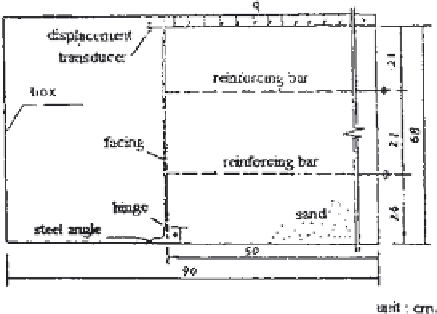Geoscience Reference
In-Depth Information
2.2 Influence of Modulus of Reinforcing Materials on the
Stability of a Reinforced Retaining Wall
A model of a reinforced retaining wall is shown in Fig. 3. It consists of a test box
with dimensions 940
490mm, reinforcing materials and backfill, and a
steel front facing that can rotate around a hinge connected with a rigid base. The
backfill used was gap-graded sand with internal friction angle f
¼
32
8
.
The pressure cells and the displacement transducers were employed to measure
the load applied on the top of the backfill by jack and horizontal displacement
of the top of the front facing, respectively.
Three series of tests are performed in which the model walls with one layer,
two layers, and without any reinforcement were used. In these tests of reinforced
retaining walls, the three kinds of reinforcing material used were gauze, flexible
plastic synthetic, and strengthened window net, which were noted as material A,
B, and C, respectively. For material C, the tensile strength is 33 N/mm, the
modulus is 5.7 N/mm; for material B, the tensile strength and modulus are
10 N/mm and 0.4 N/mm, respectively; for material A, they are 12.4 N/mm and
2.6 N/mm. The test results with one layer of reinforcement are shown in
Figs. 4
and 5. Some conclusions can be drawn from the test results. The deformation and
the failure mode of the reinforced retaining wall are significantly affected by the
stiffness of the reinforcing material. The retaining wall reinforced by the stiffest
material, C, was ruptured brittly. The failure surface consisted of two planes, with
the upper one being nearly vertical, and the distance between the failure surface
and the front facing tending to 0.3H, where H was the height of wall. The failure
surface of the retaining wall without any reinforcement was almost in conformity
£
390
£
Figure 3
Schematic view of the model test.










Search WWH ::

Custom Search